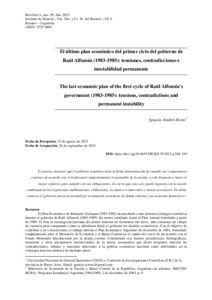Please use this identifier to cite or link to this item:
https://repositorio.uca.edu.ar/handle/123456789/17528| Título: | El último plan económico del primer ciclo del gobierno de Raúl Alfonsín (1983-1985) : tensiones, contradicciones e inestabilidad permanente The last economic plan of the first cycle of Raúl Alfonsín's government (1983-1985) : tensions, contradictions and permanent instability |
Autor: | Rossi, Ignacio Andrés | Palabras clave: | DEUDA EXTERNA; INFLACION; MACROECONOMÍA; BANCO CENTRAL | Fecha de publicación: | 2023 | Editorial: | Pontificia Universidad Católica Argentina. Facultad de Derecho y Ciencias Sociales del Rosario. Instituto de Historia | Cita: | Rossi, I. A. El último plan económico del primer ciclo del gobierno de Raúl Alfonsín (1983-1985) : tensiones, contradicciones e inestabilidad permanente [en línea]. Res Gesta. 2023, 59. doi: 10.46553/RGES.59.2023.p.166-194. Disponible en: https://repositorio.uca.edu.ar/handle/123456789/17528 | Resumen: | Resumen: El Plan Económico de Bernardo Grinspun (1983-1985) desarrollado como primera estrategia económica durante el gobierno de Raúl Alfonsín (1983-1989) fue menos estudiado frente al Plan Austral formulado a partir de 1985. Si bien la estrategia keynesiana del primer ministro de Economía fue breve, aún constituye un campo de vacancia para comprender cómo se abordaron desde el gobierno los desafíos económicos. Con el objetivo de contribuir a su conocimiento, el trabajo aborda el Plan Económico Argentino de diciembre de 1984, formulado conjuntamente entre el Ministerio de Economía y el Banco Central en el cuadro del cierre de un acuerdo con el Fondo Monetario Internacional por la deuda externa. Contrastado con fuentes periodísticas, bibliográficas, memorias y otros documentos institucionales de la época, sostenemos que dicho programa muestra las contradicciones, debates y tensiones inherentes a la política económica nacional como debilidades en la estrategia macroeconómica de mediano plazo. Abstract: The Economic Plan of Bernardo Grinspun (1983-1985) developed as the first economic strategy during the government of Raúl Alfonsín (1983-1989) was less studied compared to the Austral Plan formulated from 1985. Although the Keynesian strategy of the Prime Minister of Economy It was brief, it still constitutes a vacant field to understand how the economic challenges were addressed from the government. With the aim of contributing to its knowledge, the work addresses the Argentine Economic Plan of December 1984, formulated jointly between the Ministry of Economy and the Central Bank in the framework of the closing of an agreement with the International Monetary Fund for foreign debt. Contrasted with journalistic, bibliographical sources, memoirs and other institutional documents of the time, we maintain that said program shows the contradictions, debates and tensions inherent to the national economic policy as weaknesses in the medium-term macroeconomic strategy. |
Cobertura Espacial: | Argentina | Cobertura Temporal: | SIGLO XX | URI: | https://repositorio.uca.edu.ar/handle/123456789/17528 | ISSN: | 2525-0884 (online) 0325-772X (impreso) |
Disciplina: | HISTORIA | DOI: | 10.46553/RGES.59.2023.p.166-194 | Derechos: | Acceso abierto | Fuente: | Res Gesta. 2023, 59 |
| Appears in Collections: | RG - 2023 nro. 59 |
Files in This Item:
| File | Description | Size | Format | |
|---|---|---|---|---|
| ultimo-plan-economico.pdf | 445,95 kB | Adobe PDF |  View/Open |
Page view(s)
16
checked on Apr 27, 2024
Download(s)
187
checked on Apr 27, 2024
Google ScholarTM
Check
Altmetric
Altmetric
This item is licensed under a Creative Commons License

